
- CHANGE MAKERS
- INDIVIDUALS
- ORGANIZATIONS


Presentation Vs. Facilitation
What’s the difference.
Presentation and Facilitation. They’re pretty common terms in our training and development world, so we’re sure you’ve heard them both before too. But have you ever found yourself wondering “what’s the difference?!”
We see where some confusion could creep in.
“If I’m facilitating, aren’t I also presenting?” “If I am presenting, don’t I need some facilitation skills as well?” “ What’s the difference?!? ”
Not to worry! Let us offer a couple of guidelines to help keep them straight and help you know what matters most for each.
Presentations

People-positive
Focus on the people in front of you. Remember all the good they bring with them to the table and think about what they want to hear from you. Being people-positive shapes the words you use and the way you present. It allows you to connect with the people in front of you, and think of what they might want to know about the topic at hand, rather than just presenting your topic from your own lens.
Content-passionate
When you are the presenter, you are the expert in the room. You need to have passion for whatever the subject matter is. Your level of enthusiasm will directly impact that of your audience! Being content-passionate means you bring knowledge and excitement for your topic, but you also anticipate, recognize, and effectively respond to any counter-arguments.
Facilitations

Being people-positive is just as important for facilitators as it is for presenters. Remember – how you think about the people around you will shape the words you use and the way you use them. When you’re anticipating or managing bad behaviors (distractions, side-bars, late arrivers, discussion dominators, etc.), don’t throw any person under the proverbial bus! Protect each person in the room and correct whatever behaviors need to be corrected. As facilitator, part of your role is to make sure everyone remembers the value of each of the other participants.
Content-neutral
When you are the facilitator, it is important for you to know just enough about the topic for you to effectively lead the conversation, while also remaining neutral enough that the participants can follow the facilitated process to produce the stated outcomes. If you have a strong bias about the topic or the outcome, you’ll have a harder time being neutral in the facilitation. Your passion for the topic may be misconstrued as a bias for or against any of the people in the room, which quickly erodes the safety of the collaborative environment. When distractions, dysfunctions, and disagreement reign, successfully collaborating to achieve the desired outcomes is seriously compromised. As facilitator, the safety and success of the collaborative experience should be a higher priority to you than the actual decision or conclusion reached.
Now that you know some differences, could your presentation skills use some polishing? Could you use a few new tools in your facilitation toolbox? Contact us to hear about our upcoming offerings!
Topics: YP , Sinikka Waugh , Business Skills & Business Acumen , Communication & Collaboration

About the Author
Sinikka waugh.
Sinikka Waugh is a recognized leader in understanding people and in adapting tools, techniques, and processes to meet the demands of the situation at hand. Since 2006, Sinikka has provided compassionate leadership in transformation initiatives. When she isn’t in front of a class, she enjoys putting her background in English and French Literature to work, by writing blogs about the subjects she teaches every day. Are you ready? If you are, please don’t hesitate to reach out to us! [email protected]
Receive a weekly dose of inspiration in your inbox by signing up for our weekly newsletter
Frequently Asked Questions
Our History
Our Culture
Connect with Us
Subscribe to our newsletter
Quick Reference
Course Catalog
Resources & Tools
Internship Quick Reference
Coaching Quick Reference
The Even Better Podcast
Affiliations
We are proud members and supporters of the following organizations:

Your Clear Next Step © 2020. All Rights Reserved. | Website by WinCommunications .
- Skip to primary navigation
- Skip to main content
- Skip to primary sidebar
- Skip to footer
hr bartender
WORK RESPONSIBLY
- Free Resources
43 | December 8, 2016
The Difference Between Training, Facilitation and Presentations
I’ve been going to a lot of conferences lately and noticed that people are using the terms training, facilitating, and presenting interchangeably. And for the purposes of a conversation, it might be perfectly acceptable to use the terms in that way.

But when it comes to execution, the terms are different and the word could create expectations for the audience. For example:
Training is the action of teaching a person a specific skill or type of behavior.
Facilitation is the act of helping other people to deal with a process or reach an agreement or solution without getting directly involved in the process, discussion, etc.
Presentation is an activity in which someone shows, describes, or explains something to a group of people.
So, if I attend a facilitated session, I expect the facilitator to stay out of the conversation. If I attend a training session, I expect activities and skill practices . And, if I attend a presentation, I expect something like a lecture. I believe this is important, because audiences make the decision to receive information a certain way and when the speaker doesn’t deliver the session in the way that was expected, well…it can be a letdown. It can also be ineffective.
All three of these delivery methods require pre-work. Training is best when a needs analysis is completed . Facilitation requires gathering information about the situation or issue to be discussed. And presentations are researched. While it is possible to combine some of these methods, there are limitations. For example, when working on a presentation, it might be tempting to include some training type activities. But in many presentations, the speaker does not have access to an audience analysis, a key piece of information in the training analysis.
One of the reasons I wanted to bring this up, is because I’ve noticed a lot of speakers moving toward this combination of training/presenting and I don’t think it’s as fluid as one might think. I totally understand the concept of entertaining education and that can happen in both training and presentations. What I’m talking about is the “Let’s do an activity!” during a presentation. There are three things to keep in mind:
The activity needs to be relevant . I understand that many people like interaction so putting an activity in the presentation is well-received. But the activity needs to have a point or takeaway. Now, I’m going to be brutally honest here: I’ve never been a part of a three-minute breakout discussion during a conference presentation that yielded an epiphany. Yes, it can be fun, but there’s never enough time allocated to make the conversation effective or relevant. Which leads me to my next point…
The activity always seems to take longer than expected . I’ve seen many sessions where the speaker asks the group to take 2 minutes to discuss something. Depending upon the size of the group, the two-minute activity becomes five or sometimes ten minutes. Primarily because the speaker has a hard time getting control of the group again. It’s easy to do this type of activity during a presentation with small groups. With large groups, it can get out of control.
When you lose control of the group, you lose control of your session . I’ve seen more speakers lately do an activity then rush through a dozen PowerPoint slides because their timing is off. So, the audience misses out on information . . . because of an activity . . . that wasn’t really relevant in the first place. This can frustrate the audience because they were expecting a presentation and they didn’t get it.
As we continue to tell employees they need to own their career development , employees are going to place emphasis on the methods that information is being shared. Because they have a goal to gain valued information. And the company is holding them accountable for getting that information. So, speakers need to be cognizant that training is truly interactive, facilitation is objective, and presentations accomplish certain goals.
That doesn’t mean presentations should be boring. It means that they need to be relevant and well-managed.
Image captured by Sharlyn Lauby after giving a presentation at KronosWorks 2016 in Orlando, FL
Related Posts:

Managers Should Encourage Employee Development

7 Essential Elements in Customer Service Training

5 Ways to Use On the Job Training to Develop Employee Skills

We All Need a Little Nudge Now and Then
Reader Interactions
Diane Asenoguan says
December 8, 2016 at 5:58 pm
I love this article and I will share it. I am absolutely in favor of conducting a TNA before embarking on any training program. Sadly these days employers rush into the trap of purchasing a program without knowing if it is the right one and the right time for their staff. I worked in a government Health environment that was constantly under major change. Two major trauma hospitals merged on one campus and the result was horrendous for staff. Two different philosophies of health care thrown together and staff told just to get on with it. It made no difference the amount of training offered to staff, it was totally the wrong time. What was needed was facilitation and emotional support to all staff trying to fathom out what their responsibilities were every time they started a new shift. Training programs are essential and can improve workplace performances and increase production, but training itself doesn’t necessarily fix a cultural issue within any organisation.
Sharlyn Lauby says
December 9, 2016 at 4:51 pm
Thanks for the comment. I agree that training isn’t the answer for everything.
[…] Training, facilitation and presentations are very different. Each have their own set of official – and unofficial – guidelines. Know and follow them. […]

Never Miss an Article Sign up for free
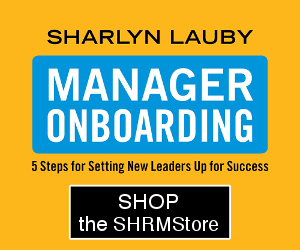
- Privacy Overview
- Strictly Necessary Cookies
This website uses cookies so that we can provide you with the best user experience possible. Cookie information is stored in your browser and performs functions such as recognising you when you return to our website and helping our team to understand which sections of the website you find most interesting and useful.
Strictly Necessary Cookie should be enabled at all times so that we can save your preferences for cookie settings.
If you disable this cookie, we will not be able to save your preferences. This means that every time you visit this website you will need to enable or disable cookies again.
Facilitation is the act of engaging participants in creating, discovering, and applying learning insights. Facilitation is different from presentation, where one person talks to a group in a "sage on the stage" manner. Facilitation usually involves a “guide on the side” who asks questions, moderates discussions, introduces activities, and helps participants learn.
This necessary and evolving skill is particularly important for talent development professionals who conduct in-person or virtual training. However, many other professionals also use it to direct team projects, task forces, committees, and meetings of any type.
Facilitation is one of the 23 capabilities in ATD's Talent Development Capability Model . You can find more information in the Talent Development Body of Knowledge . ATD Members have access to a variety of useful tools- Learn More.
Facilitation is a technique used by trainers to help learners acquire, retain, and apply knowledge and skills. The facilitator introduces participants to the content and they ask questions. The trainer leads the discussion, enhances the learning experience, and provides suggestions. They do not, however, do the work for the group; instead, they guide learners toward a specific learning outcome.
ATD's Handbook for Training and Talent Development outlines five tactics to help maintain learner engagement:
Define success ahead of time, so you can design activities to help learners achieve a specific goal.
Prepare relentlessly, including self-preparation, preparing the learning environment, and preparing the content. When moving from an in-person classroom to a virtual environment, follow these tips .
Start with impact so that learners are excited, empowered, and involved from the beginning.
Keep learners interested by using different activities like questions, role plays, and practice exercises. Let them share their experiences and learn from each other during the session.
Address problems when a student is unhappy with training. Whether intentional or not, lack of satisfaction can come from the overall goal, material, approach, or outside influences. Within talent development, facilitation most often refers to a technique used during in-person or virtual classroom learning. However, people can also use similar techniques in meetings or other group settings. These techniques help a group improve how they work together, identify and solve problems, make decisions, and handle conflict.
The facilitator helps the group work better together by creating synergy, coming up with new ideas, and reaching agreements. You can hire a professional facilitator to assist with meetings. Sometimes, a senior leader, manager, consultant, coach, or another professional can also lead sessions. This person can be from inside or outside the organization.
Whether in a classroom or a meeting, effective instructors must focus on group dynamics and processes. They are ultimately accountable to the group and must earn the group’s trust .
What Are the Differences Between Facilitation, Presentation, and Training?
Trainers help others improve their performance by teaching, instructing, or aiding learning. As such, facilitation and presentation are both tools in a trainer’s toolkit. The best trainers spend more time guiding learning than lecturing. The role of the facilitator often reflects that of a trainer.
Presentation vs. Facilitation
|
|
Delivers information, usually through a lecture. | Enhances learning for everyone, usually through discussion or activities such as role plays. |
The expert sharing their knowledge of the subject matter. | Provides opportunities for members of the group to share knowledge and learn from one another. |
Spend most of the time talking. | Spends most of the time asking questions, encouraging others to speak, and answering learners’ questions during activities. |
Usually on a stage or at the front of the room. | Usually moving around the classroom to help address learners’ questions or monitor how activities are progressing. |
Facilitator Skills
Facilitators can come from any background and a variety of experience levels. They demonstrate the following skills:
Listening- listen actively and hear what every learner or team member is saying.
Questioning- be skilled in asking questions that are open ended and stimulate discussion.
Problem solving- be skilled at applying group problem-solving techniques, including:
defining the problem
determining the cause
considering a range of solutions
weighing the advantages and disadvantages of solutions
selecting the best solution
implementing the solution
evaluating the results.
Resolving conflict- recognize that conflict among group members is natural. As long as people express conflict politely, there is no need to suppress it. Expect and deal with conflict constructively.
Using a participative style- encourage all learners or team members to actively engage and contribute in meetings. This will vary depending on individual comfort levels. Create a safe and comfortable atmosphere in which group members are willing to share their feelings and opinions.
Accepting others- maintain an open mind and not criticize ideas and suggestions offered by learners or group members.
Empathizing- be able to “walk a mile in another’s shoes” to understand the learners’ or team members’ feelings.
Leading- keep the training or meeting focused toward achieving the outcome identified beforehand.
Preparing for a Facilitation
Facilitation is equal parts preparation and delivery. Ask yourself these questions to prepare for a session:
Environment- Where will the session take place? Virtual? In-person? Synchronous vs. Asynchronous? How will we set up the desk and chairs? Is the space easy to access?
Technology- What systems does your session require? A microphone? A clicker? Do you need tech support on stand-by? What virtual platform will you use?
Materials- Will you provide notes or learning guides? Will you have visual examples? Do you need to create a video for the session? Will you reference books or other reading excerpts?
Yourself- What is your role in the facilitation? What are your strategies for maintaining the right level of engagement? How will you fill your own knowledge gaps? Do you need to practice public speaking?
These are just a few of the questions to get facilitators started on preparation. There are many "what-ifs" that facilitators cannot prepare for ahead of time. For example, you cannot control if learners complete the pre-work. Focus on what is within your control.
These questions and other tips come from ATD's Facilitation in Action: Finding Your Authentic Training Style. Read more from ATD's Facilitator Team: Carrie Addington, Jared Douglas, Nikki O'Keeffe, and Darryl Wyles.
Common Facilitation Tools
A training program might use a combination of the following tools to guide learning for long term success:
Group Discussions- often useful for addressing skills gaps. Grouping people with different experiences allows an exchange of new ideas and fresh perspective.
Online Learning - can be an individual online course or group online training. This can be both synchronous or asynchronous.
Team Building Exercises- ideal for a small group. This technique helps grow an organization's culture and creating a comfortable space for learning.
Development Programs- learning done over a set period. This enhances the learning process by allowing space for memorization and recall.
How ATD Can Help
Looking to develop your facilitation skills or upskill your team? Explore ATD's "Training and Facilitation" Certificate to develop your skills as a trainer and facilitator.
Free Facilitation E-Book
Effective facilitators also focus on the group dynamics and processes, and are accountable to the group; therefore, the facilitator must earn their trust.
National Extension Water Outreach Education
Division of extension.
Home » Water Outreach Education » BEP Website Resources » Use Education Resources » Tools for Teaching » Facilitation Skills: Introduction » Facilitation Skills: Presence and Presentation Skills
Facilitation Skills: Presence and Presentation Skills
Tools for teaching navigation.
Facilitation Skills : The Art of Group Facilitation
- Self-Mastery Skills: What Does It Mean to Be a Facilitator?
- Presence and Presentation Skills
- Relating Skills: Communication, Listening, Questioning
- Group Awareness and Management Skills
- Logistic Skills
Teaching and Presentation Skills : Keep these techniques in mind
Enhancing Your Facilitation Skills
A meeting is any time two or more people come together to accomplish something in particular. What is achieved depends greatly on how you plan in advance, interact with leaders and participants, set the stage for the work ahead, adjust your strategy as needed, and bring closure.
Guidelines for Facilitation
The following provides guidance in these areas. (adapted from Oakley & Krug, 1991; and materials available at the change agency.org )
Explain your role and responsibilities to the group: Clarify what you will do, what you will not do, and how you will help them achieve their objectives.
Focus your attention on the goals of the group: Don’t let fear, nervousness or other emotions keep you from serving the group’s needs and don’t let your facilitation skills serve as a vehicle for your personal and professional growth.
Always use a systematic approach : At the beginning of every meeting or training session, state the purpose of the meeting or program, review the agenda and then clarify roles.
Test frequently for understanding of basic assumptions and agreements: This will help to avoid misunderstandings as you work through the process .
When necessary, just say “no”: If an assignment is not a good opportunity for you to provide service, turn down the request to facilitate. If all you are going to do is write-up the minutes of a meeting, handle other administrative tasks, or serve as a vehicle for the chairperson’s desire to pursue a hidden agenda, decline the opportunity to facilitate. If you can’t say no, make a counter offer by suggesting what you can and should do.
Meeting Enhancers
When we begin, end and keep the meeting on track, value can be added to the quality of the meeting and the results produced. This leads to high levels of trust and cooperation (Butler, 1996).
Openers: Reinforce What Is Important
The following questions suggest ways that any meeting can be started and can build a foundation of trust, openness and cooperation:
- What have you accomplished since we last met?
- What are you working on right now that you are excited about?
- What has your team learned from its progress on this project?
- What’s something you would like to be acknowledged for?
- What do you appreciate about __________(team member)?
- How would you describe what you’d like to accomplish in this meeting?
Keeping Aligned: Ask Open Questions
- What’s making the most sense about what we’ve covered so far?
- What could I do to help us better achieve our goals for the meeting?
- How can I support you?
Meeting Closers: Let the Group Be the Last to Talk
- What have you appreciated most from the time we have spent together today?
- What have been the two or three biggest benefits you’ve received from this meeting today?
- In what specific ways will you be able to apply what you have learned?
- What have you learned that might help us to be a better team?
- What can you be counted on to do?
The 'Never Evers' of Workshop Facilitation
Much has been written about planning effective workshops and staff development sessions. Many of these articles provide specific ways to increase the effectiveness of the session. These articles have generally suggested “what works” in workshops.
Experience and research also indicate certain things that a facilitator should never do during a workshop. I have gleaned these “never evers” from observing other presenters, conducting my own workshops, consulting with experts, and reading the literature. As a thoughtful reminder place this list of “never evers” near your other workshop materials.
- Never ever forget that individuals at the workshop are unique, with needs, interests, and experiences particular to them.
- Never ever require individuals to participate in an activity.
- Never ever talk to participants as if they are children.
- Never ever ridicule participants or their experiences.
- Never ever neglect the participants’ personal needs.
- Never ever say that you are going to rush through and compress material in order to complete what is usually a longer workshop in a shorter length of time.
- Never ever say that you would have brought more materials if it had been possible.
- Never ever tell participants what you’ve forgotten.
- Never ever give excuses.
- Never ever read from a lengthy prepared text.
- Never ever share illegible handouts.
- Never ever share a disorganized “mishmash” for a handout.
- Never ever give participants something to read and then read it to them.
- Never ever share overhead transparencies that participants cannot see or read.
- Never ever share with participants a workshop schedule that is impossible to follow.
- Never ever go past the scheduled time.
- Never ever forget that you have an audience.
- Never ever take the workshop so seriously that everyone (including the facilitator) cannot have fun.
Butler, A. S. Team Think . (1996). The McGraw-Hill Companies, Inc.
Oakley, E. and D. Krug. (1991) Enlightened Leadership: Getting to the Heart of Change. Simon & Schuster.
Sharp, P.A. (Dec-Jan. 2000). The ‘Never Evers’ of Workshop Facilitation . Tools for Schools, National Staff Development Council, [ NOTE : details summarized in the link above by the same name]
Adapted with permission from Soil and Water Conservation District Outreach: A Handbook for Program Development, Implementation and Evaluation . Ohio Department of Natural Resources, Division of Soil and Water Conservation, 2003.
We teach, learn, lead and serve, connecting people with the University of Wisconsin, and engaging with them in transforming lives and communities.
Explore Extension »
Connect with your County Extension Office »

Find an Extension employee in our staff directory »

Get the latest news and updates on Extension's work around the state

Feedback, questions or accessibility issues: [email protected] | © 2024 The Board of Regents of the University of Wisconsin System Privacy Policy | Non-Discrimination Policy & How to File a Complaint | Disability Accommodation Requests
An EEO/AA employer, University of Wisconsin-Madison Division of Extension provides equal opportunities in employment and programming, including Title VI, Title IX, the Americans with Disabilities Act (ADA) and Section 504 of the Rehabilitation Act requirements.
- NEW! Exploring The University and Higher Education World
- NEW! What Makes Teaching And Training All Worthwhile
- Training and Development Crossword Puzzle
- Articles - Training and Development
- Training and Development FAQ (Questions and Answers)
- Library (over 1,000 curated articles)
- Bacal's Books
- Our Unique Mini-Guides And Tools For Trainers
- Video Section
- Classroom Emergency: Unexpected Help Needed
- Robert's First Day Teaching (and his unplanned urinary event)
- Simple Powerful Model For Understanding How To Make Training Powerful
Browse The Training & Development Knowledgebase
- Index Page - Training and Learning Myths and Stupid Trainer Tricks
- The Trainer's SURVIVAL Manual
- Instructional Methods and Training Methods
- Instructional Design
- Training, Lectures, Presentations
- Starting Off A Training Seminar Successfully
- The Business of Training
- Issues In The Training Industry
Browse Frequently Asked Questions About Training, Learning and Development
- Expert Articles On Training And Development Challenges
- Training Games, Activites, IceBreakers Free To Use
- The Training And Development Library: Close to 1,000 selected articles on improving training and development
Do NOT Miss
- The Fundamental Flaw That Causes ALL E-Learning To Founder. It's Genetic
- Neuroscience Applied To Learning And Teaching: We're Not There Yet
- Still believe in the importance of learning styles? You won't after you read the articles and research in this section.
A Research Primer For Trainers And Teachers
Trainers and teachers NEED to be able to understand how research is done in education and learning.
- We've created a three part article that explains how it works, and guaranteed, you learn something you don't know about how to use research in your training and teaching environment.
Neuroscience, Learning And Teaching
- Visit our reference page that looks at whether neuroscience actually results in better instruction. You'll be absolutely surprised at the consensus of the experts. Written for teachers but equally applicable to training.
There are several key differences between delivering a training program, and delivering a lecture or a presentation.
Flow Of Information
A major difference between training and lecture/presenting has to do with how the interactions and information flow. In a lecture or presentation, the major flow goes from the speaker to the audience. Generally, that means that interactions between audience members is low, as is interaction starting from the audience members to the speaker.
Training, however, is far more flexible with information going in all directions -- it's far more interactive.
Different Purposes Or Outcomes Expected
The second major difference has to do with the purpose of the event, or the outcomes expected.
Presentations and lectures are informational in that the attendees are exposed to information, but the emphasis is on exposure rather than learning that can be applied in the real world. It's not that presentation information is irrelevant to real world behavior -- it's that the emphasis is different.
Training, however, is designed to alter the capabilities of attendees (learners), and to build new capabilities that can be used "out there".
One way to make the distinction is to say that presentations involve "learning about", while training involves "learning to do".
Presentations Have Wider Range Of Outcomes
While training should always be about "learning to do", presentations actually have many more possible outcomes, which need to reflected in how the presentation is planned and executed. Presentations can be of various types, depending on whether the presentation is intended to:
Lectures Often Half-Way Between Presentation and Training
It's not quite that simple, because lectures are often part of training, and are intended to result in learning, while that's not the case with all presentations. Still, lectures involve an information flow from teacher to learners that is primarily one way.
That's why, in educational and "learning to" situations, it's important to alter the flow somewhat so that lecture segments are interspersed with thinking exercises, and most important questions to audience members.
About Company
Bacal & Associates is a small training, consulting and publishing company specializing in customer service, communication, performance management, and other management challenges.
Privacy Policy
Our Related Sites
It Takes A Village To Teach A Child For teachers, educational administrators and parents.
All About The Workplace Our main site with over 400 articles on life in the workplace.
Improving Customer Service Dedicated to improving customer service, and customer service strategies for business
Small Business Resource Center For all things related to small business owners and those considering starting a small business
We believe in a lean, information packed user experience. We limit the use of graphics and stress quality content. We also believe in a NO HYPE environment. Our product and service descriptions are free of overblown claims, and selling.
Get in Touch
- Phone: (613) 764-0241
- Email: [email protected]
- Address: 722 St. Isidore Rd. Casselman, Ontario, Canada
Copyright © 2000 - 2018 By Robert Bacal. All Rights Reserved.
Facebook Twitter Google+ LinkedIn library Rss
What are facilitation skills and how to improve them?
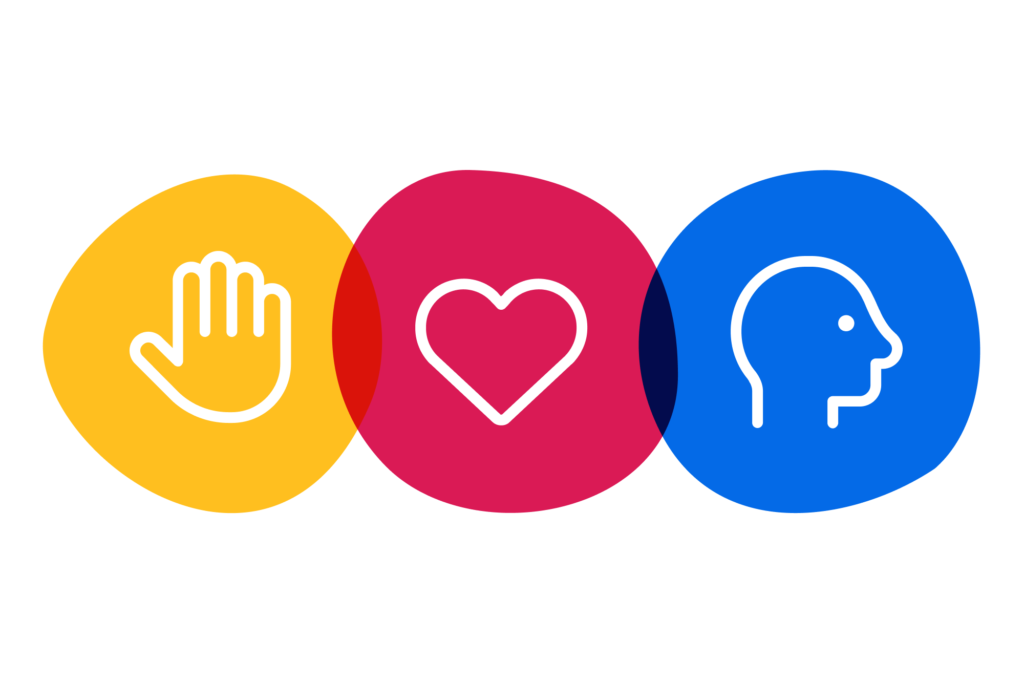
Facilitation skills are the abilities you need in order to master working with a group. In essence, facilitation is about being aware of what happens when people get together to achieve a common goal, and directing their focus and attention in ways that serve the group itself.
When we work together at our best, we can achieve a lot more than anything we might attempt alone. Working with others is not always easy : teamwork is fraught with risks and pitfalls, but skilled facilitation can help navigate them with confidence. Facilitation can be a workplace superpower.
Design your next session with SessionLab
Join the 150,000+ facilitators using SessionLab.
Recommended Articles
A step-by-step guide to planning a workshop, 54 great online tools for workshops and meetings, how to create an unforgettable training session in 8 simple steps.
- 18 Free Facilitation Resources We Think You’ll Love
Whatever your position, career path, or life story, you probably have some experience in facilitation skills, although you might not think of it this way.
Chairing a committee, getting the neighbors together to clean a park, playing music with your friends, organizing a wedding celebration, observing a group of kids play and suggesting something they might want to do next: there are many unexpected corners where you might be already practicing facilitation skills.
When we start to recognize and meaningfully improve these key facilitation skills, that’s when we can begin to achieve real change in how we work together with others.
In this article, we will look at what facilitation skills are, including practical abilities (such as timekeeping during meetings), life competencies (such as communication skills), and components of the facilitation mindset (such as trust, and neutrality). Read on to explore what facilitation skills are, how they could be useful in your life and work, and ideas on how to practice them further.
Why are facilitation skills important?
Facilitation skills are invaluable in many situations, such as:
- managing team meetings ;
- improving participation and engagement at events and conferences;
- increasing clarity in group processes , getting everyone on the same page;
- including a diversity of opinions and stakeholders;
- evaluating choices, creating action plans as a group;
- ultimately, supporting the group in making actual, effective progress toward its goals.
Facilitation skills are about being great at collaboration. There is very little we can actually achieve on our own: facilitation skills help make teamwork more effective, break communication barriers, and ultimately help us realize more ambitious goals.
An effective facilitator can help encourage participation and involve everyone in the process – by learning and developing these skills, you too can empower the group to reach a successful outcome. Without facilitation skills, energy, resources and momentum can easily get lost and wasted. This might happen through unresolved conflicts, or because of confusion over next steps, or low motivation. For anyone working with groups, facilitation skills are useful, but for leaders, they’re practically a necessity.
When are facilitation skills used (and by whom)?
There is an ongoing debate in the facilitation community around whether facilitation is a profession or a set of skills that can be put to use in any context. The answer, ultimately, is both.
Myriam Hadnes, the host of the Workshops Work podcast, put it well in this interview with Sarah Norton and Steve Ray from the Australian Groupwork Centre : if people know how to cook, does this mean they no longer need chefs and restaurants? It’s actually the opposite: the more cooking skills we have, the more likely we are to fully enjoy a chef’s craft. Viewing facilitation as a craft is a helpful framework. If facilitation is a craft, anyone can learn it. At the same time, people who devote their whole career to facilitation will achieve higher levels of mastery.
In practice, this means imagining a world in which most people know how to apply facilitation skills to their work, as well as when to call in someone more experienced when need be. To learn more about what professional facilitators do and what you should know before hiring one, you can check out our blog article on What is a Facilitator and What do They Do .
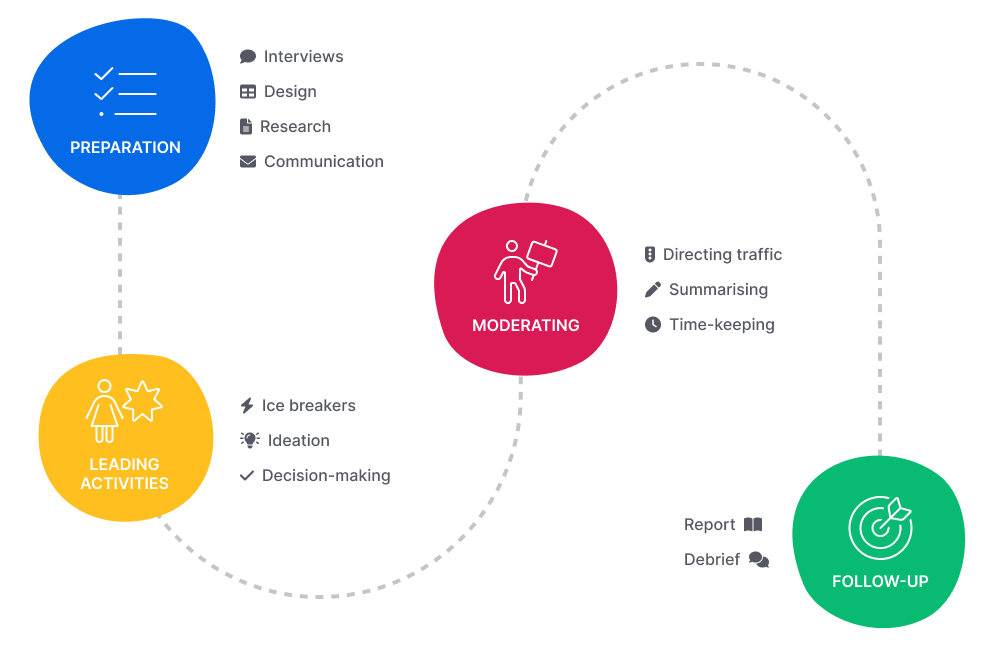
What are facilitation skills?
Facilitation skills are a set of competencies and soft skills that enable professionals to design and facilitate group processes effectively.
In practice, facilitation skills are most often used when designing and then leading groups through a collaborative process such as a worksho p (for more on what workshops are, you can read our guide here).
The version of facilitation most of us are familiar with includes using activities, tools, and methods in a workshop setting. Experienced professional facilitators develop an extensive toolkit of proven-to-work processes, activities, and templates for this purpose.
Facilitation is also about all the backstage work of preparing and designing meetings , events, and activities, shaping agendas that will provide the structure for the entire group to move along and achieve its desired goals.
There are a number of software tools that help professional facilitators deliver great sessions. But before that happens, there needs to be planning: SessionLab makes it easy to build a complete agenda in minutes . Start by dragging and dropping blocks, add your timings and adjust with ease to create a minute-perfect session.
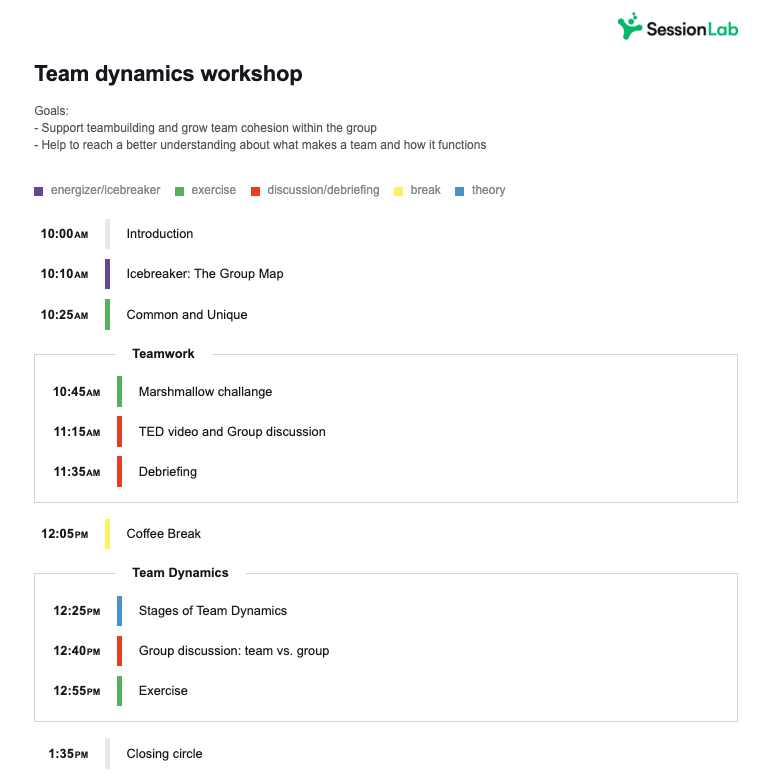
As might be clear by now, there is more to facilitation than meets the eye. Below the surface lie life competencies and skills related to communication, time management, conflict resolution, project management, listening, and more. An effective facilitator can do much more than facilitate meetings and solve problems! Facilitation skills are the sum of all these competencies.
In the next paragraphs, we will go through some of the essential facilitation skills, through the lens of the “head, hearts, and hands” framework.
Having defined facilitation as a practical craft, we’ll start with the hands: what are the practical facilitation skills you need to master when working with a group? Then we will look at what could also be called life competencies, the “head” of facilitation : what do you need to know? This is the realm of frameworks that will help you understand the concepts behind group dynamics.
Last but certainly not least is the “heart” of facilitation : the facilitative mindset, which is really key to getting great results when working with your groups.
Here is a list of what we’ll be looking at. You probably have some of these skills already: which are you strong in? Which would you like to further develop?
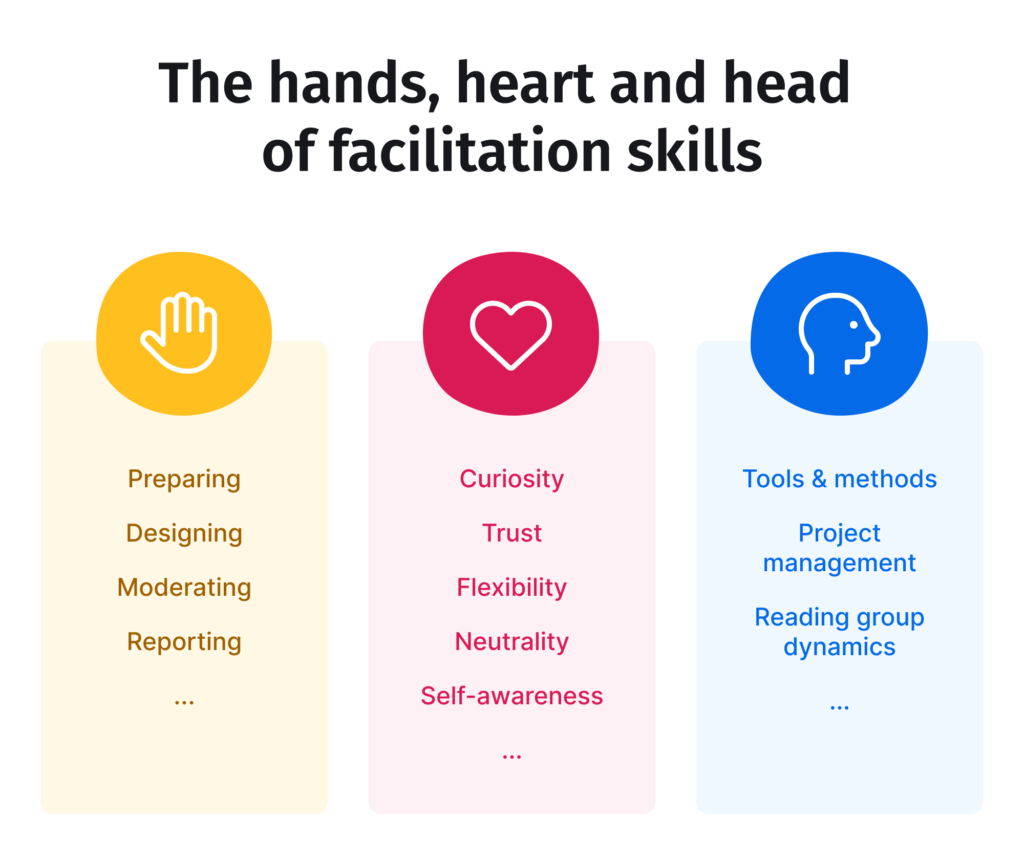
Practical facilitation skills
The best way to learn and improve your facilitation skills is to practice, practice, practice. Meetings and events are the most logical place to start. Consider how your meetings are already going. What works well? What needs improvement?
We have collected below the most important practical skills that a facilitator needs, divided into two parts of the facilitation process, preparing and running a session.
What would the ideal state of your meetings and events look like? These are the facilitation skills that can help you get there!
Facilitation skills for preparing a meeting
The general rule of thumb says that preparing for a group facilitation session usually takes twice as much as the actual net meeting time where the facilitation takes place. At the design stage, we define the needs and outcomes of the process and create a structured agenda of activities. Foresight is certainly part of the facilitation mindset! To learn more about workshop design, here is an article that goes through the process step-by-step.
Now let’s see what specific skills you will need for the planning process and to help design anything from a training session to a workshop like an expert facilitator.

Asking powerful questions
Any meeting or workshop needs to have a clearly defined goal, and as a facilitator, you need to be clear about the objectives. Ask questions to understand the underlying motivation behind a meeting and develop a consensus with the client about their goals. What outcomes do they hope to achieve? Why is the meeting being called? Who should be there? What will define success?
You might go further by creating a needs assessment to understand what the different stakeholders of an event might want in order to come up with a solution that meets your client’s needs. A hallmark of effective facilitation is clarity and purpose .
Process design
Once you know the outcomes you want to achieve, it is time to find the right process. But what does it mean to “find the right process’?
- As a facilitator, you are helping the group think together. So, finding the right workshop or meeting process is about finding the structure that will help groups to think and work together effectively. This may be an open discussion, or a structured one, where you as the facilitator use different techniques to help participants to exchange viewpoints, analyze issues, generate ideas and make decisions.
- A common structure for group facilitation discussions is to apply Divergent and Convergent Thinking . First, you enable the group to broaden their horizons and generate new ideas or solutions. Then you help them narrow down the set of options they have created to make a final decision.

- Finding the right process also includes considerations around what will keep participants active and engaged. Group engagement is something the facilitator should be conscious of throughout the workshop. Often times you will elect to use specific facilitation techniques to keep your session interactive and keep participation high. You might set ground rules that make it easy for group work to take place effectively or use activities expressly for encouraging participation.
- Keep in mind the session’s purpose, so you can design a suitable process . A workshop facilitator must pay particular attention to this in order to ensure the entire workshop can help even small groups move towards a productive outcome.
- If you (and the group) have multiple desired outcomes, make sure that you have a clear process to reach each of them. This can be where your group facilitation skills can be tested if you haven’t carefully constructed a process for your workshop or meeting. Remember that a facilitator needs to prioritize and have realistic expectations of the group. Be critical in this stage of the design process so that your facilitation does not suffer from being overwhelmed during the meeting or workshop.
Agenda planning
Congratulations, you have a process! Next, you need to make sure that your process works with the reality of time constraints, logistics, group dynamics, and the attention levels of people joining you (which are also different whether you are working in remote facilitation or in person!).
Proper planning is one of your most important facilitation skills. Your facilitation practice will benefit from nailing this stage and learning from it for future workshops and meetings.
There are several factors to consider when planning a workshop agenda:
- Time constraints : A session has a start time and an end time, and participants usually expect you to respect the end time.
- Breaks : If your session spans longer than 90-120 minutes, you should likely include some breaks in your session, for instance, coffee breaks or a lunch break.
- If you want breakout sessions to run parallel tracks in your session
- How different sub-groups will report back to the whole group
- Break the ice : Are participants familiar with each other or not? This, and the nature of your sessions, determines how much effort will be needed to break the ice and allow people to get to know each other . Knowing who is in the room and meeting at a personal level are necessary steps to build enough safety and trust for a productive session.
- Interaction mix : There are different types of interaction, ranging from one-to-many forms of presentations to individual work, small group and large group discussions. A healthy balance of different interaction types throughout your session will help participants to stay engaged by catering to their different ways of learning and being. Make space for different ways of thinking and a mix of contributions by varying the pace and style of activities.
- How will the room and environment support active participation? Plan proper room and seating arrangement s and remove barriers in the room. It’s easy to make assumptions or forget, but the room, physical environment, and workshop set-up can make facilitation easier or harder. Plan ahead and be aware of the logistics for any meeting or workshop you are leading as a facilitator.
- Is virtual facilitation a consideration? How will you cater for an online audience and design for online tools?
- How will one topic of the meeting flow into another one ?
- Closing and wrapping-up: How should the sessions be properly ended?
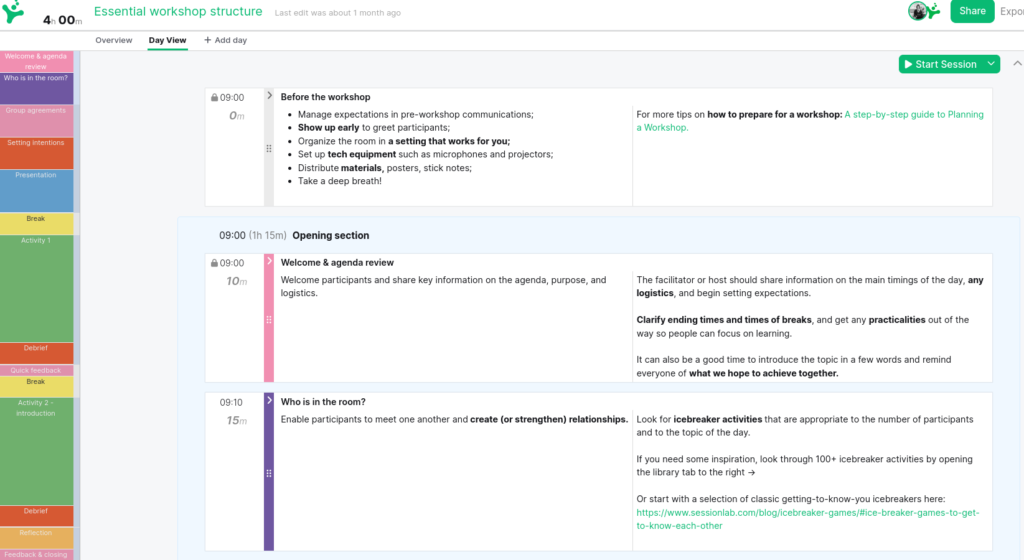
Facilitation skills for running a meeting
After proper preparation, the most exciting part of a facilitator’s work is actually running and managing the session and guiding people through the process. Let’s see what facilitation skills a facilitator needs here.
Create an inclusive environment
Participation from all group members is essential for a well-facilitated meeting. One of the most important things you can do as a facilitator is to co-create an atmosphere that encourages participation. This comes partially from your session design: include ice-breakers and get-to-know games to help people open up and start speaking. Another part is ensuring that the room’s setting supports active contributions from people. Meaning, make sure everyone can see each other and removing barriers from the room (this is even more important in hybrid meetings , where part of the group is in the room and others join online). Group facilitation is hard if the group can’t hear one another! Inclusion is also modeled in how you behave towards the group. A skilled facilitator will validate different opinions , ask curious questions, and look for ways to include quieter people in the discussion (e.g. by inviting written contributions, paired conversations, activities where speaking in turns, going in circles, and so on). A diversity welcome is a great way to start a session aiming for inclusion!
Communicate clear guidelines and instructions
While you designed the agenda for your session, you probably clearly envisioned how participants will act during the facilitation activities you planned. Now that you are in the room with the group, you also need to clearly explain what you are asking from them. Effective facilitation is predicated on clarity. Here are a few practical tips to help:
- Explain why certain activities are useful.
- Set ground rules for participation and communication.
- Clearly and sequentially explain the steps participants will take.
- Be clear about time constraints.
- If possible, show an example of the type of output you are asking participants to create.
- Show instructions in a visual form for all participants to see (e.g. pre-write instructions on a flipchart paper or on a slide.)
Skills to moderate conversations
There are a number of basic techniques and simple verbal tools that a facilitator should be able to use confidently at meetings in order to facilitate discussions, engage participants and make sure everyone is involved.
This is the aspect of facilitation that includes moderation or “directing traffic” skills and these can have a massive impact on a team’s performance during a session.
- Probing : Probing is used to determine the mood or general opinion of the group about a certain topic or point in the discussion. Just asking for a “thumbs up-thumbs down” survey can be enough to get an impression of the general opinion of the group.
- Paraphrasing : Paraphrasing means to express the same content that was just stated before but in your own words in order to check that both you and the others have the same understanding.
- Redirecting questions or comments : Redirecting a question to the group helps get participants more involved in the discussion. In addition, it also encourages group reflection.
- Bridging and referring back: This helps the group follow the discussion and to connect ideas by recalling earlier discussions or ideas.
- Shifting perspective : If the group gets stuck at some point in the discussion, try to shift the perspective and look at the problem from a different angle.
- Summarizing : Repetition promotes understanding, and summarizing what has been discussed so far will help participants build upon the conclusions they have already made.
- Giving positive reinforcement : It’s important to encourage people, especially those who are less assertive, to state their opinions. Therefore, when someone brings up a good point, say so, thus showing his/her participation is appreciated, and later on he/she will feel confident enough again to bring up another idea. Don’t forget that body language also has a part to play here!
- Including quieter participants : Encourage less talkative members to contribute to the discussion. Ask directly for their opinions and ask if they have any questions. At the same time, keep in mind that people do have different learning and thinking styles and may not feel comfortable if they are ‘encouraged’ too much. A facilitator needs to be alert to the needs of different participants and help everyone move forward together.
Conflict management
The ability to handle and diffuse tension is a skill that sets expert facilitators apart from others. Group facilitation is often exciting and productive, though differences of opinion can form in workshops or meetings you might be facilitating. A good facilitator isn’t someone who actively avoids such differences but embraces them, and uses a combination of critical thinking, active listening and other skills to help a group navigate such differences.
Remember, the group has a goal, and individual differences will need to be handled to achieve that. Given the time and scope of the session, not every interpersonal difference can or should be resolved; however, it is important that you know the right techniques and group processes for diffusing tension. Sometimes this might mean breaking up the work into smaller groups, taking a break, shifting perspectives or changing the scenery.
Handling challenging situations
Dealing with conflict-stacked situations is among the biggest challenges to facilitation. Often, there are underlying conflicts behind disagreements taking place in a conversation, even in small meetings. The facilitator role often means being attuned to this possibility and responding appropriately.
You might also encounter participants who express challenging behaviors. People have reasons for behaving as they do, and if you don’t make an effort to understand their stance, they might keep playing hardball in the session. B alancing attention to individual needs and to the whole group can get tricky!
At certain times, you may be better off trying to speak to that person in private to discover what drives them, and at minimum, give feedback to help them understand how their behavior affects the group. Interpersonal communication is again an important part of facilitation and ensuring you have these facilitation skills can make your job in a workshop much easier.
Consensus-building skills
Different points of view naturally emerge in a discussion. It is the job of the facilitator to help the team find common ground among different opinions, helping the group arrive at a decision that is accepted by everyone.
Consensus, in this context, does not mean that everyone must agree with the final decision but that everyone gets an opportunity to share their opinion with the group, and that people are aware of the reasons why a particular decision was made.
In other words, this is called creating a transparent process . For instance, if you choose to use simple dot-voting as the technique to come up with a set of the most preferred ideas after an idea generation activity, then everybody should be made aware of why only those most popular ideas will be considered further. In that way, everyone understands the process that leads to a final decision. (Setting ground rules at the outset is a great way to make this clear to everyone in the room!)
For more on how group facilitation deals with decision making and building consensus, read our guide to participatory decision-making .
Time management
Meetings have time limits. This is especially true in effective and productive organizational cultures. A carefully crafted agenda must take into account how much time can be allocated for each activity during a session.
Part of the facilitator’s role is to guide the group in timely conversations and decisions and stay focused throughout. It is important that you are aware of the passing time during a meeting and that you let participants know when time is running short for an activity. In general, good facilitation assumes efficient timekeeping, with only well-grounded exceptions for going overtime in discussions.
If you are facilitating a meeting, participants will assume the timekeeping role is 100% up to you. But you can also decide to share the burden of facilitation with the group, for example by assigning another person to be the timekeeper .

Record outcomes
Recording key takeaways of a conversation is essential for keeping group progress on track and avoiding circling back to the same topics. As a competent facilitator, you should make sure to capture and highlight the key messages – whether that is via visual recording (i.e. arranging post-it notes, sketches, etc. made by participants), or written records (i.e. writing up conclusions).
You may also ask a participant to assist with minute-taking or have a dedicated visual practitioner to capture outcomes. All the insights recorded will provide a useful baseline for action-setting and follow-up.

Facilitation skills as life competencies
Life competencies are clusters of related skills and abilities that enable a person to act effectively in a real-life situation. They are more complex than the practicalities of managing a meeting or a group of people, but the good news is they can be picked up and practiced in all sorts of situations. Here are some of the higher-level skills practiced by facilitators:
Act ive listening skills
A basic condition for an effective conversation is that people feel they are being heard and listened to. Active listening is one of your best group facilitation skills and it is often the foundation for a productive discussion.
Practice your active listening skills as a facilitator, and encourage all participants to do the same. Also, basic verbal tools, such as paraphrasing, referring back and summarising help a lot to show the group that their thoughts are being heard. A facilitator understands that being an active listener also means using positive feedback to encourage quiet people to get directly involved in the session. If you were to work on improving just one facilitation skill, this is a great place to start.
Project management skills
There are numerous minor tasks and to-dos on the logistic side of preparing a workshop. In some cases, you may get a helping hand from the client’s side, and someone will help you to have everything arranged as you have designed and requested. In other cases, you might need to do this alone step-by-step, checking that everything is going fine with the logistics and pulling the right strings when something is needed. Whether you run a dedicated planning session for your workshop or communicate with clients and participants over email, staying organized is an important job you can’t afford to miss. Getting the room properly set up for a meeting is important. So is having catering arranged in order to ensure food and drinks are available during breaks, and having the right workshop equipment at hand.
This can be easy to overlook, but ensuring you get this right is part of facilitation best practices. Missing a vital piece of equipment can be frustrating or stressful and make group facilitation more difficult.
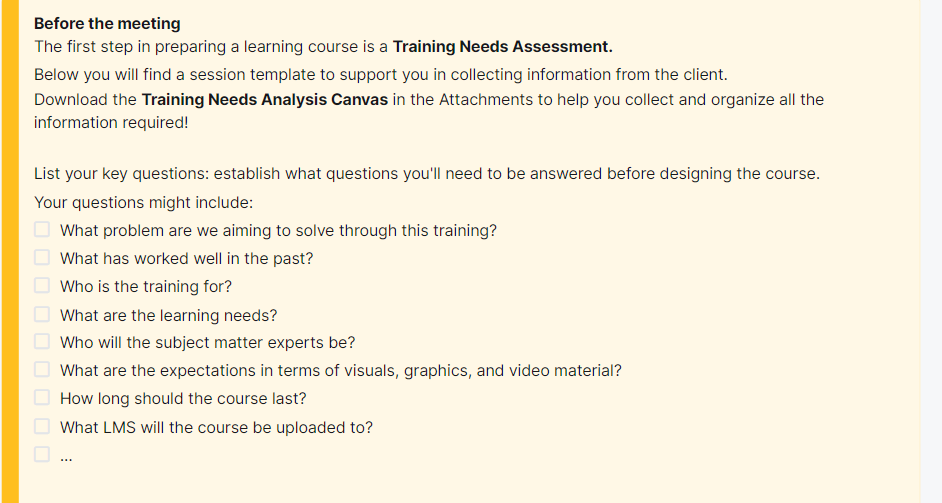
Communication
In most cases, it is necessary to inform the client about the process that you are planning, and, in general, to maintain steady communication to make sure that all preparations go smoothly. The best facilitators are in contact with their clients throughout the process and may even get in contact with some of the participants. Good communication at all levels is absolutely integral for a good facilitator and anyone involved in group facilitation.
Most of the time your client will have a natural interest in knowing the process and agenda for your meeting. They will have a number of people attending the workshop – meetings and workshops can be particularly expensive if you consider the time value of the people present – and they want to be assured that the group will be in good hands. Therefore, it is important to keep your clients updated throughout the design process for their peace of mind. This also offers a chance to get further insights about the goals and the group, helping you to come up with the right session design.
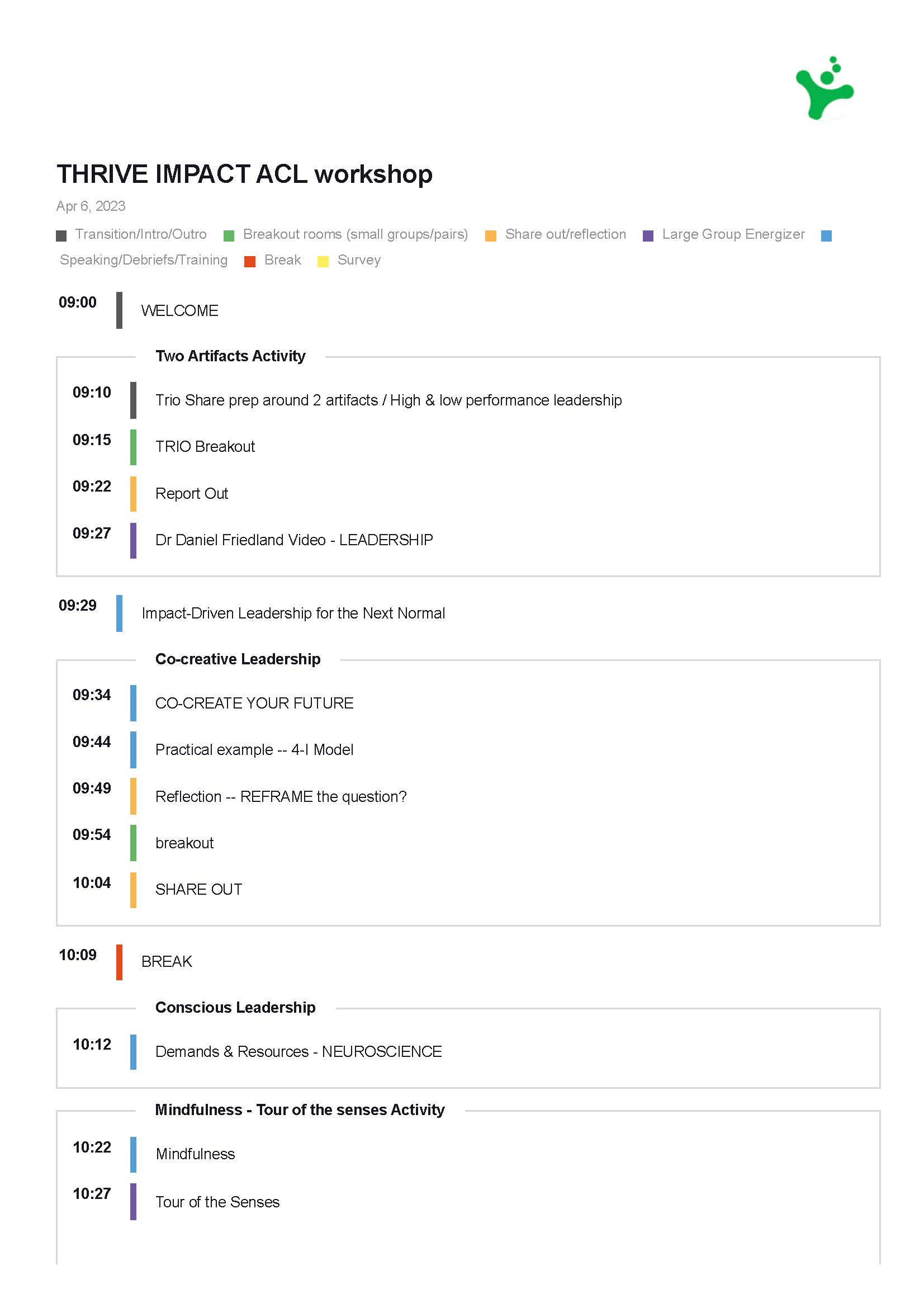
Setting up an effective workshop will require meetings with a hosting team: here you can find a ready-made template to help you steer those conversations and make sure you have everything you need!
Group dynamics and managing group members
Any group of people has its own dynamics dependent on the specific interrelations between its members. As a facilitator, you want to create a participative atmosphere where everyone is involved. Paying attention to the dynamics of the group and how individuals participate is important to any group facilitation scenario. Being familiar with some group dynamics frameworks, such as the 5 stages of team development as defined by Bruce Tuckman , can help you name what is going on in the room and suggest the type of activities that will most help the group move productively through the various stages, from forming to performing and beyond.
You will need practice to master the skills of picking up on the atmosphere, measuring the emotional temperature, and helping the group achieve its potential.
Sensing the energy level in the room (and adapting to it)
Some activities require more attention from participants, some require less, but no individual will maintain the same level of attention and energy during a full-day workshop. And that’s alright. As a facilitator, you should have a good eye for spotting when the group’s attention level is getting critically low.
You can make sure to design sessions with varying group activities to keep people engaged, and give regular breaks every 90-120 minutes at least. If you sense motivation dipping, try some energizer activities to instill energy in the room. Other times, what is actually needed is more akin to a moment of grounding, focusing, or quiet personal reflection.
Outdoor activities , including sending participants for a brisk walk, can do wonders, and so can a well-thought-out use of music in a workshop (including in remote facilitation!). An excellent facilitator develops a sense of what the group needs and has a suite of team-building activities they can employ at a moment’s notice too.
Facilitation as a mindset – the heart of facilitation
At its core, facilitation is about holding a group process as participants navigate deep and shallow waters, turbulence and calm. Methods, tools and frameworks will in and of themselves help improve your events and meetings. But reaching breakthroughs and achieving higher potential takes more than that. A highly skilled facilitator embodies certain qualities in their posture and body language, in the tone of their voice and the micro-expressions of their faces. They bring calm, clarity and purpose to a room. Yet, even such subtle facilitation skills can be practiced. In the next part we will look at some elements of the facilitation mindset (the “heart” of facilitation) and tips on how to practice them.
Curiosity is a core element of a facilitation mindset. If there is a lot of chatter in the room, or a heavy silence, or someone presenting a challenging behavior, a facilitator’s knee-jerk reaction should be to be curious about it. What is happening? What is this telling me about the group in this moment?
Practice curiosity during meetings by imagining any disturbance or difficulty as a messenger bringing you an important bit of information about the group. Are we in need of a break? Is there an unspoken issue to be brought into the light? If you notice something of this sort, you do not need to take upon yourself the whole responsibility of solving the problem. Naming what you think might be happening and “throwing it back” to the room as a question for the group is a very typical thing for an effective facilitator to do.
Facilitation is about believing the group has the tools and skills needed to solve its own problems. Trusting the group can be difficult, especially if you are also an expert in the content, or perhaps a manager, and feel you might have some answers yourself. If that is actually the case, there is nothing wrong with providing ideas and opinions, but you should make sure you are well aware of when you are “wearing the facilitator’s hat”, so to speak, and where you are putting it down to take on another role.
A good facilitation game to practice trust is the Human Knot . In this fun exercise, participants literally tie themselves up in knots; besides giving instructions, your only role as facilitator is to believe that the group can do it (they will) and tell them so. When we hear someone believes in us and our own ideas, we can achieve incredible things!
Practicing trust has a lot to do with practicing listening skills. If you catch yourself thinking something along the lines of “This group is hopeless, they will never solve this!” step back, observe, look for what is working well in the group, and take notice of what happens. Be prepared to be surprised!
Flexibility
Facilitation is a dance of improvisation and structure. You have a set agenda and activities you want to go through, and it’s important to make sure you reach your objectives. At the same time, you are working with living, breathing human beings: what actually happens when we gather is always a bit unpredictable. Facilitation skills include being able to sense what is going on, ask the group questions, and change course based on what is happening at the moment. This is part of why so many facilitators have some training in improv theatre!
Planning a good process for an event will help you immensely. Being prepared means you will confidently be able to handle unforeseen situations and adjust the pre-planned process more easily as necessary. Usually, activities and discussions end up taking more time than initially planned: the group might need more breaks; new agenda items may pop up; and so on.
As a facilitator, being able to adapt on the fly is an essential skill, and it is also necessary to communicate and confirm the potential changes to the agenda with the group. At the end of the day, as a facilitator, you are helping a group achieve the common and agreed-upon objectives they want. So, if there are any changes to said objectives, they should be agreed upon by the group. Co-facilitation is immensely helpful with improvising and adapting. Having an extra person as a sounding board allows you to check in with one another, see if you have noticed similar patterns and needs, and ideate changes together.
Neutrality is at the core of facilitation yet, at the same time, it is one of its trickiest principles. The idea here is that the facilitation should stay neutral on content while being an expert on process . It’s not about your ideas, it’s about supporting the group in achieving what they want.
However, there are situations when a facilitator does have a natural interest in the conte nt. After all, one cannot bring an external neutral facilitator for every single meeting in the world. If for any reason you are not content-neutral as a facilitator, you should be clear about this with the group from the beginning. Try to make it explicit when you are wearing your ‘facilitator hat’ and when you are using your ‘participant/content-expert hat’.
Another way to look at the idea of neutrality is to remember that it doesn’t mean “not having a position” but rather having the very special position of “allowing and enabling all positions”, or being “multi–party”. Practice this by getting involved in processes and sectors which you know very little about!
Self-awareness
Group processes are human and messy (even when you know the frameworks and are proficient in group dynamics!). People, including the facilitators, get triggered. Misunderstandings arise. Someone hijacks the meeting for their own purposes. Clients get nervous. The projector stops working. Shit happens. Being aware of our own responses is key to keeping our cool in such situations and, thereby, staying helpful to the group. Self-awareness also means creating your own set of principles, values and skills that are important to your own facilitation practice. Practice self-awareness by reflecting and debriefing after any facilitation experience. The effective facilitator is one who is always learning. You can do it on your own, preparing your own template of reflection questions (what went well? What would I do differently next time?), asking for feedback from participants and getting peer feedback or mentoring from other facilitators.
How to become a more effective group facilitator
The best way to get better at facilitation is to practice, practice, practice ! Over hundreds of hours of meeting facilitation, you will encounter a myriad of different situations in group dynamics: heated debates, opinionated participants, challenging power plays, as well as happy teams, effective meetings, increased opportunities for collaboration, and creative breakthroughs. The broader your facilitation toolbox is, the more skilled you will be in applying the right processes to guide each unique group’s thinking.
How to improve your facilitation skills
There are a few ways you can accelerate your learning in the realm of facilitation and to go from being a good facilitator to a great facilitator. Let’s see some of them.
Participate in facilitated spaces
Finding opportunities to watch other facilitators on the job is a great way to learn and to understand what type of methods and styles are right for you. Take part in workshops, even if the topic is not very familiar to you, to see how others work. You don’t need to travel the world to get exposed to great facilitation. SessionLab’s friendly community has a calendar of free events you can attend, and we regularly highlight upcoming facilitation events in our newsletter .
Join a community
Facilitation communities are on the rise. From our own SessionLab community to local communities of practice, facilitation communities were quoted by facilitators as one of the best places to stay updated and learn new skills, based on the State of Facilitation report . You can also get together with a few interested people around you to form a peer group and support one another in your learning.
Co-facilitate with experienced facilitators
On-the-job learning from seasoned veterans is probably the most effective way to level up your skills. Strive to design facilitation processes together with other facilitators , and you will encounter different perspectives on how to design an effective group process. Co-facilitate discussions, and you will gain first-hand experience in observing how different strategies work to manage conversations.
Explore new tools and techniques
Keeping an open mind and staying ahead of the curve is important. Find time to learn and experiment with new tools and techniques to stay up-to-date. Read books, watch videos and share best practices with colleagues. SessionLab’s library of tools and facilitation newsletter are great ways to start!
Get trained (and potentially certified)
You may consider attending a general facilitation training, or get trained in specific facilitation frameworks or facilitation skills. The State of Facilitation 2023 report revealed a surprising multitude of options to get trained on specific methodologies, as well as clarifying that there is no single pathway to becoming a facilitator. Facilitators come from all sorts of backgrounds and walks of life! Whether you are a beginner or professional facilitator, facilitation training can help you grow and refine your practice.
At the end of the day, facilitation is more of a craft than a science . The more you do it, the more sophisticated your skills will become! Reflecting and debriefing on what you noticed others do in their facilitation practice, as well as on your own skill development, is essential to improving your skills. In many ways, the best facilitation training is being on the job as a facilitator.
Read (and listen to) group facilitation materials
Read through the State of Facilitation report for insights on what facilitators do to stay current, ideas on what communities to join, tips on favored podcasts and books, and an overview of what the profession looks like today.
The International Association of Facilitators has developed a competency framework and a code of ethics to support facilitators and clients. These revolve around 6 core competencies, in which you will recognize facilitation skills in action:
- Creating Collaborative Client Relationships;
- Plan Appropriate Group Processes;
- Create and Sustain a Participatory Environment;
- Guide Group to Appropriate and Useful Outcomes;
- Build and Maintain Professional Knowledge;
- Model a Positive Professional Attitude as a Process Facilitator.
Reading through the framework is an enlightening way to understand what facilitators do in practice and what skills they apply.
Learn about group facilitation with an email course
Here at SessionLab we have created two email courses, Facilitation is for Everyone! and Overcoming Facilitation Challenges , which you can sign up to (for free) to receive inspiration and facilitation stories straight in your inbox. Read more on all the resources we’ve put together to start your facilitation journey !
Over to you
Are any important facilitation skills missing from the list above? Do you have questions about something not covered in this post? Join the conversation in the comments or in SessionLab’s friendly community space !
Robert took his first facilitation training in 2009, and since then immersed himself in designing and delivering experiential learning experiences, group workshop, and train-the-trainer/facilitator programs. His passion for facilitation led him to co-found SessionLab, the online platform that helps people design and facilitate better workshops.
72 Comments
I have yet to read a more comprehensive, systematic and immediately applicable article on Facilitation! Invaluable! Thank you ????????????
You’re welcome, Franklin! I’m really glad that you’ve found the article useful!
This is a very good article. It responds to most of the questions I get for prospecting people to the Association of Facilitators. Thank you.
That’s great to hear, Jeanne! I’m glad to hear that you’ve found it useful :-)
wonderful article, i have understood the accountability, transparency and its systematic ideology of knowing a facilitator owes and often it encourages in orgonisations…
Thank you for sharing your thoughts, Chance, great to see that the article inspired some further reflections :-)
Excellent knowledge that is spot on!! Appreciate the effort behind this.
You’re welcome, Chandan, awesome to see that you liked the post!
Super interesting article and the links to toolkits! much appreciated. Thank you so much
You’re welcome, Anna, great to hear you’ve found it interesting!
Wonderful article,thank you!
You’re welcome, Neda!
This blog post of facilitation skills is excellent! Thank you.
That’s great to hear! You’re welcome, Michelle!
thanks for putting great taught together. i now have deep knowledge on facilitation i will be using most of ideas in engaging my staffs
You’re welcome, Idirssa! Wishing best with your next sessions!
Hi Robert, your sharing is very practical. May i share it with my team of business leaders as we are asking them to become our internal trainers. Very challenging….
Thanks in advance.
You are more than welcome, Joseph – glad to see you’ve found it practical!
Hi, Robert! The article is very educative and will go a long way in helping my work. Bravo.
Abdullahi Kirim.
Awesome – happy to hear that it helped! :-)
Thank you for the helpful ideas. My experience is that facilitating when there’s a team with a well-understood, shared culture and goals is one thing, facilitating an ad hoc group of (e.g., citizens) on an issue, such as zoning requirements, is different. Two skills I think are required are: a) Either having subject knowledge or being adept at “learning the case” (i.e., becoming knowledgeable enough to make reasonable judgements as you guide the process); and b) Understanding the fundamental principles of “social learning” — the iterative exchange of knowledge between subject “experts’ and the most critical stakeholders. The “social learning” process takes time, but enables the stakeholders to a) become empowered to influence the outcome, and b) more able to contribute well-informed opinions or ideas. Equally important, it enables the “experts” to absorb an understanding of the context (both concrete and social) so they can offer better advice. I’ve watched way to many City planning processes go nowhere (or blow up) because a) the City staff hired a “neutral facilitator” who wasn’t neutral to begin with and whose professional obligation is to the City Planning Director; and b) the facilitator couldn’t provide productive meeting processes because she had no clue how comments were related, relevant or within reasonable sideboards. In addition, neither the staff nor the facilitator had any understanding of the importance of “social learning” so very little exchange occurred.
Thank you, Paul, for sharing your perspective – I find your example super relevant to illustrate that being neutral as a facilitator is not the same as not being knowledgeable on the subject of a session. In fact, without thoroughly understanding what the group talks about, it’s nearly impossible to steer a discussion in a productive way!
Great thoughts about being aware of the social learning process – yet another important aspect of a facilitator’s skillset!
This article on Facilitation Skills is simply awesome. Thank you so much for providing essential insights on Facilitate Skills.
Happy to hear you’ve found it useful, Suren – wishing best with your next sessions!
Simply awesome article on facilitation skills.
Thank you, Subina, glad you liked it!
Great Information and very detailed.
You’re welcome, Harry, great to see that you liked it!
Hi there. very good guide for facilitators.
Thank you, Aluma – great to see you’ve found it useful!
This has been so useful to me. Allow me to share with my group of upcoming facilitators in family planning workshops.
You’re more than welcome, Hawa – great to see you’ve found some useful nuggets of insight here!
Your article is amazing! It captured all of my questions for transitioning from trainer to facilitator! This will be my go to as a guide.
That’s fantastic to hear, Paula – happy to see you’ve found this useful!
Hi Robert- this is so comprehensive and compact! May we use it for our Facilitation class this Spring at the University of Oregon? Thank you!
Happy to hear you’ve found it useful, Devin, you’re welcome to use it as a resource at your facilitation class!
This was an excellent read and is SO informative!!! So much information here that I needed and some things that I had not thought of. Thanks for this!!
You’re welcome, Lisa, great to see you’ve found the article useful! :-)
best on topic which I came about. Thanks
Great to see you’ve found it useful, Danie!
this facilitating process is clear and understandable thank you so much
Excellent article! You’ve clearly articulated so many of the foundational pieces of preparing and facilitating a group.
Thank you, Stephan!
Very useful article
This is amazing article and more indepth, detailed learning that i have come acrossed about facilitation, infact i have learn some basics, i appreciate the efforts here, thank you!
You’re welcome, Judith – great to see you’fe found it useful!
Crisp & comprehensive,I found this very, very useful as I embark on a training for academicians who now need to shift from lecture mode to facilitation mode. Have you done any facilitation work in the teaching /academic context?
Thank, you Sindhuja, great to hear that you’ve found the guide useful. (As for your question, all my facilitation experience was in for-profit and NGO environment, so not in academia. Nonetheless, I believe that as long as the role of a facilitator is to lead/guide a group through a process to help achieve what the want, the skills and approaches above are valid for both context)
I love your site. My thanks for sharing such a good post. I was looking for thoughts on this topic last Thursday. I will come back to read more and inform my coworkers about your site.
Dear Robert, Great and comprehensive article! Thank you! I just want to share with you how I structured the facilitator role when I trained facilitators (the specific skills were assigned to the specific role) The question I answered was: what processes is the Facilitator responsible for, in order to make groups work in an effective way to achieve their common goal? • Team Building Process The Facilitator encourages the group members to know each other better, to cooperate and develop positive relationships in order to work together. • Group Communication process The Facilitator helps group members communicate effectively by overcoming communication obstacles, avoiding misunderstandings and conflict escalation • Group Decision Making Process The Facilitator helps group members make decisions in an effective way • Participatory Planning Process The Facilitator designs and guides the group members thinking through the logical path of the planning process stages. The Planning Process Stages logical sequence can be designed in different ways, depending on the context, the time available, and the complexity of the problems to be addressed. I would need to use some schemes in order to show you the logic proposed when designing different planning/problem solving processes. If you give me an email address I can share one brochure I developed where this role (which is not mentioned in your article) is described.
Hi Robert, 2 questions: – Are there some other skills that a facilitator must have for running online workshops effectively (to be added to the list). – which skills would you put emphasis on among the list of skills mentioned in the article when the workshop is virtual?
This is one of the best articles I have read. Enriched me with a lot of knowledge.
Awesome! An excellent article on introduction to facilitation. Great learning!
Great article. Very comprehensive. Do you provide training to organizations on how to facilitate meetings? We are considering having HR professionals receive training on how to facilitate meetings as part of our Diversity, Equity and Inclusion program, so they can effectively facilitate topics that may generate a lot of passion with differing points of view.
Great insight on facilitation skills Robert . I have been a practitioner for over 30 years and have learnt these skills the hard way .
Hi Mr. Robert, Superb article, it is simply awesome, If possible please help me with this how facilitation skills used in different training groups such as: 1) executive trainees (management trainees) 2) mid-career trainees 3) in-house training 4) open training programs? What are the different skills to be used?
Robert, you did an extremely excellent job, hats down in your art of turning a novice into an expert, skillful facilitator.
Thank you, Johannes – great to see you’ve found the post useful!
Very informative and useful content! Thank you for the post!
Great work. I’ve found the article very rich and useful ????
How cool! I completely agree with all the other comments on the high quality of this article. It is soo good. Thank you for sharing. :)
You’re welcome, Kay – great that you found it useful :-)
Dear Robert,
Very meaningful and a great article on Essential Facilitation Skills. Highly informative and has covered all the aspect in depth. Thank You for sharing.
Regards, Renjit Mathew
You’re welcome, Renjit!
Hello Robert, great piece to read and is so very helpful in every form. Just a question: What according to you are three most important skills related to group facilitation and how do you think they can be best applied in a group?
super super super…article. For me, it will be kept handy as a “ready reckoner”.🙏🙏🙏
Hello Robert,
What an inspiring “discovery” it has been to run across this most helpful article and walk-through on the ever-relevant topic of effective facilitation.
I just finished the digital invitation to a “Facilitators’ Workshop on Empowering Facilitation” (in Scandinavia) – and ran across SessionLab via my news stream.
I am encouraged to see how in-depth and ‘practically applicable’ you and your team have elected to remain in covering key topics related to the subject.
Thanks a million, and much Kudos to you for such a superb effort and offering!
Kristen L. Skogrand Co-Founder & Senior Facilitator EmpowerED.How (coming in Nov.:)
Hi Robert, this is a very informative article and thank you so much.
This is a great article.
Thanks for sharing these insights into the art of facilitation. It’s something I’ll keep referring to as I develop my skills.
5 years on this article is still being shared and read and is still excellent – thanks
Leave a Comment Cancel reply
Your email address will not be published. Required fields are marked *

Going from a mere idea to a workshop that delivers results for your clients can feel like a daunting task. In this piece, we will shine a light on all the work behind the scenes and help you learn how to plan a workshop from start to finish. On a good day, facilitation can feel like effortless magic, but that is mostly the result of backstage work, foresight, and a lot of careful planning. Read on to learn a step-by-step approach to breaking the process of planning a workshop into small, manageable chunks. The flow starts with the first meeting with a client to define the purposes of a workshop.…

Effective online tools are a necessity for smooth and engaging virtual workshops and meetings. But how do you choose the right ones? Do you sometimes feel that the good old pen and paper or MS Office toolkit and email leaves you struggling to stay on top of managing and delivering your workshop? Fortunately, there are plenty of great workshop tools to make your life easier when you need to facilitate a meeting and lead workshops. In this post, we’ll share our favorite online tools you can use to make your life easier and run better workshops and meetings. In fact, there are plenty of free online workshop tools and meeting…

How does learning work? A clever 9-year-old once told me: “I know I am learning something new when I am surprised.” The science of adult learning tells us that, in order to learn new skills (which, unsurprisingly, is harder for adults to do than kids) grown-ups need to first get into a specific headspace. In a business, this approach is often employed in a training session where employees learn new skills or work on professional development. But how do you ensure your training is effective? In this guide, we'll explore how to create an effective training session plan and run engaging training sessions. As team leader, project manager, or consultant,…
Design your next workshop with SessionLab
Join the 150,000 facilitators using SessionLab
Sign up for free
- Client/Member Login
- Grow your firm Grow your practice Grow your self
- The Rainmaker Academy®
- The Leadership Academy
- Five Star Client Service Program
- Growth & Leadership Skill Courses
- On-Demand Business Development Training
- Custom In-House Training Programs
- Personal Growth & Leadership Coaching
- Growth Capability Assessment
- Strategic Growth Planning & Consulting
- Client Loyalty and Win-Loss Reviews
- Market Potential and Targeting Analysis
- The Rainmaker Growth Teams Program™
- Sales Process and Methodology
- Pursuit and Client Team Coaching
- Firm Forum & Retreat Facilitation
- Lead Generation Campaigns
- Communities
- CEO Grow Community

- Client Successes
Facilitation vs. Presentation: A Hallmark of the Skilled Advisor

Think about a time when you’ve gone through a complex decision process to make a major purchase such as a house or car. Did an agent work with you through the process, asking questions, understanding your unique needs, and making recommendations accordingly? Or were you presented loads of options (relevant or not) to sort out, and then left to draw your own conclusions? Remember how you felt throughout – Comfortable and confident that you would be guided to the right solution? Or stressed and confused, worried about making a bad decision?
Similarly, professional service advisors have a critical responsibility to help clients navigate complexity to craft solutions to their challenges. However, the style used to accomplish this varies widely, and thus has a profound impact on the client’s experience and the success of engagement outcomes. Incorporating more facilitation versus presentation in your advisory meetings can be a powerful step to building trust with clients and co-developing more effective solutions for them.
Do you tend to be more of a facilitator or a presenter? Examine your personal style across these five key attributes, and consider adjustments you can make to enhance your client advisory technique.
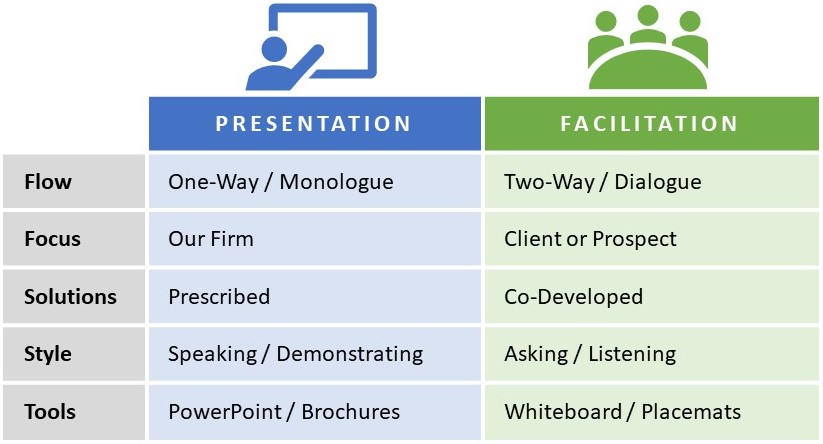
Flow : Presenters may prepare carefully with thoughtfully timed and well-rehearsed presentations. However, they do most of the talking and leave little room for dialogue with the client. Facilitators prepare agendas around well-crafted questions and build in time where appropriate to collaborate and work on important issues.
Focus : Presenters concentrate on articulating their own capabilities, accolades and ideas in an attempt to dazzle the client. The lens tends to be turned to the firm. Facilitators, on the other hand, turn the focus to the client. The firm’s experience and credentials are conveyed indirectly by the quality of the questions asked by the facilitator.
Solutions : Presenters tend to make assumptions of client needs based on past experience and surface exploration, often resulting in cookie-cutter recommendations. Facilitators delve into the uniqueness of each situation and are skilled at discovering the true hot buttons of the client. This can expose needs in addition to (or instead of) those originally expected.
Style : Presenters prefer speaking opportunities in which they can deliver a controlled message. This may include systematic demonstrations of products or services. Facilitators favor interactive discussions and are skilled at asking questions in a structured way that gets productive dialogue flowing.
Tools : Visual aids such as PowerPoint presentations and brochures are common tools of choice for presenters. They are materials prepared in advance and designed to support the presenter’s intended messages. Facilitators favor tools and media that support collaboration. Whiteboards, for example, can be used to create and capture concepts as they develop. Placemats can be prepared with partial information to provide a discussion framework, while also providing space for documenting key ideas.
Professionals striving to adopt more consultative techniques can significantly enhance their advisory skills by facilitating with clients more than just presenting to them.
If you are interested in learning more about this or other practice development strategies, please contact us to schedule a complimentary consultation, or attend an upcoming Rainmaker Growth Teams™ workshop .
Scott Moore – Executive Vice President of The Rainmaker Companies
You May Also Like

Are You Viewed as Transactional or Transformational?

Stop Selling and Start Helping

Power Up Your Productivity and Profitability

Business Development in a Time of Uncertainty

©2024 The Rainmaker Companies | All Rights Reserved built by Ah So

- Bronze Membership
- Silver Membership
- Facilitator Gold Academy
- Meetings That Rock LIGHT
- Meetings That Rock ESSENTIALS
- How to Lead Engaging Meetings
- ToP Facilitation Methods
- ToP Facilitation Methods ONLINE
- ToP Environmental Scanning
- ToP Strategic Planning
- Facilitator Mentor
- Large Group Facilitation
- PATH Session
- Strategic Planning
- Team and Leadership Development
- Our Mission and Values
- About Founder
- Our Associates
- Facilitation Certification
- Facilitation Videos
- Helpful Links
- Reading Room
- Diversity Cohort Project
- Global Facilitation Poetry
- Sustainability Tips
5 Big Differences Between Training and Facilitation
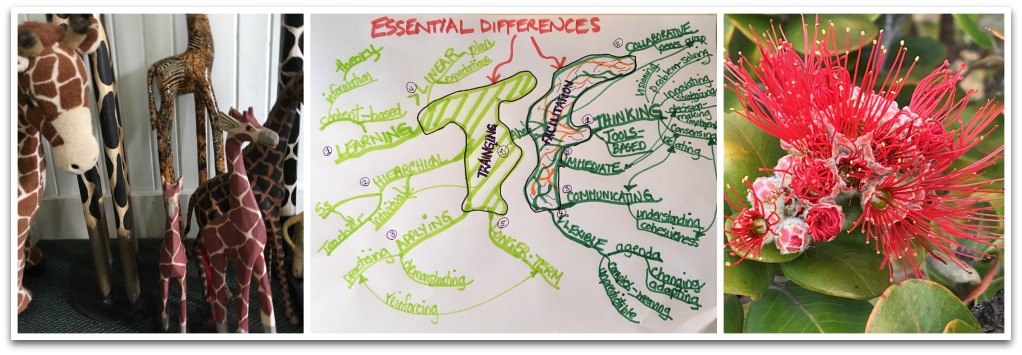
The reason I’m addressing the topic is that many of us think that training done interactively is very close to or even the same as facilitation. It can feel like that but there is an essential and critical difference. This blog will cover those differences, talk about the benefits and when to use each mode. Also, I’ve made a short video for those of you who are thinking about when to hire a trainer versus a facilitator.
I have a bias, as I would say there are distinct advantages of using a process facilitator over a trainer in many more circumstances than you’d think. Yet I want you to know that I have great respect for many colleagues who are amazing interactive trainers and provide a great service to their clients. I also think I’m really good at training. However, there is a very specific time when trainers are best used and times when it’s better to use a facilitator. That is what I will try to clear up here.
If you are currently a trainer moving into the field of the facilitation, you might find this blog gives you the language to help your clients decide when to use you as a process facilitator versus a trainer.
We say this Blog is primarily for Stage 1 or the “Seeker” stage of the facilitator journey. However, I think it will be pretty interesting to the latter stages as well simply because you’ve wrestled with this. Many of us who own our own facilitation business or are employed within an organization to do OD work or process facilitation, are also called upon to clearly distinguish the difference between the two fields for prospective group work. It is up to you to know when one intervention is better than another.
What are the essential differences between training and facilitation?
There are five. I’m going to start first with the main emphasis of each field then move on to some of the structural, outcome and tone differences.

The essential first difference between the two fields is first and foremost that training is about passing on learning and content . The training provides theory, information and activities to share and help retain the information. On the other hand, process facilitation is about helping the thinking in a group . The main difference is in almost simplistic terms: training is about learning and facilitation is about thinking.
Here is a 2.5 minute video to explain this a bit more:

The second big difference is the trainer really has to offer quite a bit of content in large or small blocks. So the emphasis is on a hierarchical model where the trainer is the teacher and the learner is the student who supposedly knows less than the trainer. That might be the assumption of the student although it’s not necessarily the assumption of the trainer.

The third is that the trainer is really helping the group to apply the content he or she has given them . So the training would ideally contain a lot of demonstrating, practicing, and reinforcing of the concepts that have been shared.

The forth difference is in the design. I hope I’m not offending any trainers by my choice of words. But because training or education comes from a hierarchical model, there tends to be more of a linear plan in the trainers’ outline . You decide what the learning outcomes are, you design your activities and content accordingly. And likely you rarely vary up that plan once you’ve tested and finalized your curriculum. It works well!

The final difference between the trainer and the facilitator I feel, is that the trainer is really focused on achieving a longer-term outcome . They know that one day or two days or even five days of training is not going to necessarily have an immediate impact. The concepts have to be continually reinforced, practiced, refined for each situation. If this is done well, in the long term, you will see some change. However, when the person and or the organization does not do anything to reinforce the concepts, then all that is taught is lost!
The facilitator has more of an emphasis on the short term. The result may be e.g., an immediate decision or an immediate consensus. The result could simply be a profound discussion with your colleagues about something that needs to change. When you were doing planning, although the result is an immediate documented plan, it may take a number of years to implement. In general as a process facilitator, you’re looking for short-term insights and often immediate results.
My questions to you now:
- What words would you use to describe the differences?
- How can we help HR and OD leaders make the right choice in deciding when and how to use a training format versus a facilitated process format?
- Which field do you prefer and why?

Get Free Tips & Tools for Your Meetings & Facilitated Sessions to Your Inbox Twice a Month!
Barbara MacKay
15 comments.
A fabulous article, you guys @NorthStar Rock!
Many thanks, Paul!
Very nice article, I will link to it from my own pages (www.djehoty.com). I enjoy training and teaching and I learn more and more about helping groups of professionals to get where they want. I use almost the same descriptions to underline the difference. My training and teaching is about me facilitating their learning by providing my (and other people’s) knowledge to them and or activating theirs. My facilitating is about creating a place together where they can discuss on how to use their knowledge collectively.
Thank you, Maarten! We so appreciate your feedback.
Hi Barbara, thanks for sharing such clear difference and I do agree with most of them. i just want to say it is well written, thank you. I have started to be more aware and doing process facilitation and feel that a great difference is about creating shared outcome from within the team or organization which is such a powerful space for the people. So I called process facilitation is to “create from within” and learning facilitation or training is about absorbing from outside to be digested inside that can bring more values to a person. Florence Yuen from Singapore. Just want to let you know your writing is read in Asia too.
Love your distinction of the inside piece versus the outside piece Florence. Nice helpful image! Thank you for taking the time to share your ideas!
Thank you very much for sharing this
Thank you for a very informative and educative article. It is very helpful to me. Are there more images related to the subject matter. please share.
Dear Bona Deng Lawrence, I’m so glad you found this article helpful. We think about images as metaphors and often our blogs are filled with visual aids to help the reader quickly capture the essence of the idea. Therefore, each blog has its own unique images. I apologize but we don’t have any more images to share with you. You might want to go to pixabay.com and put in word phrases that pop up for you as you try to explain a concept. And, sometimes we just use icons such as in this blog. You can also search our blog for other articles with images. Apologies if I’m not answering your question. Please feel free to ask again if I did not understand.
Hi Barbara,
I am into facilitation from the last 9 years and I have found it difficult to explain some people about the difference. I am happy that I read your post today. Now I have more in my hand to answer those who mistake me for a trainer
Thanks for sharing such an insightful post.
Dear Alok, I am very happy that you are a facilitator and that and you know that. It’s very good you know the difference. The main thing I would tell people who are asking you what the difference is, is that you are not delivering content, you are guiding process. Your participants have all the content that they need. Your job as a facilitator is to help them articulate their knowledge and experience in structured and creative ways. Then they can use the synthesis of their sharing to resolve the problem, make the decision, plan the next steps, etc. I would love to hear your ideas, Alok, about the main differences you have discovered.
Very neatly explained the difference between trainer and facilitator. I just paused for some time after each point and reflected on it. Clearly understood the differences and thank you very much :). Few thoughts flowing through my mind- Facilitation happens real-time in that present moment and outcome is unique in each session. Whereas trainer carries past session experience to present and try to adapt with new group however seeking the same predictable output.
In simple world its “I” vs “We”, “listen to me” vs “let me/us hear you” and finally “I am the BOSS” vs “you all did it”.
Facilitation is learning from group as a keep student, while creating environment where everyone would like to pour their experience and knowledge!!!
Thank you so much for sharing your reflection and insights!
[…] Yet, even in such cases, there are some fundamental differences between process facilitation and training facilitation, as highlighted by Barbara MacKay […]
Leave a Comment Cancel Reply

COMMENTS
Facilitations. Facilitating is gathering a group of people to work collaboratively to achieve a stated outcome. In this case, you have people around you who are each interested in and passionate about the subject matter at hand. Your act of service is to help them achieve the stated goal. Facilitation skills are used to prevent distractions or ...
Training is the action of teaching a person a specific skill or type of behavior. Facilitation is the act of helping other people to deal with a process or reach an agreement or solution without getting directly involved in the process, discussion, etc. Presentation is an activity in which someone shows, describes, or explains something to a ...
In its highest form, facilitation expects the participants to drive the agenda and the facilitator to guide them to achieve their objective. It also takes more time than a more conventional presentation as the group members tackle their own understandings of the topic. One is not better than the other. Presenting and facilitating are different ...
An Introduction. Facilitation is the act of engaging participants in creating, discovering, and applying learning insights. Facilitation is different from presentation, where one person talks to a group in a "sage on the stage" manner. Facilitation usually involves a "guide on the side" who asks questions, moderates discussions, introduces ...
Which will you choose, being a presenter or being a facilitator? I wrote down the differences between these two different roles to help you decide.
The terms training, facilitating, and presenting are often used interchangeably when, in fact, they differ depending on the purpose of the session. Linkedin-in Facebook-f Youtube. Webinars ; Articles Close Articles Open Articles; MyLangevin Sign-In ; Essentials Training Browse all articles .
A contract facilitator can also be very useful for team-building exercises. In contrast, presentations shine when they are used to offer information and solutions that have already been discovered. You may choose to have multiple presentations on the same topic from different individuals or groups to determine the best of the available ...
There's a big difference between facilitation and presentation. Presentations are often one-sided whereas facilitation involves audience/participant engagem...
Enhancing Your Facilitation Skills A meeting is any time two or more people come together to accomplish something in particular. What is achieved depends greatly on how you plan in advance, interact with leaders and participants, set the stage for the work ahead, adjust your strategy as needed, and bring closure. Guidelines for Facilitation The […]
Presentation vs. Training vs. Facilitation. To maximize learning retention, you need to use the right mix of telling and listening. To help you move from being a presenter to a facilitative trainer, check out our courses. The E ective Facilitator and Facilitation Skills for Trainers. For more information click the course names above or visit.
https://sholakaye.com/learning-centre What's the difference between a presentation and facilitation?Want to improve at speaking fast? Download Shola's FREE P...
A major difference between training and lecture/presenting has to do with how the interactions and information flow. In a lecture or presentation, the major flow goes from the speaker to the audience. Generally, that means that interactions between audience members is low, as is interaction starting from the audience members to the speaker.
Share. Facilitation skills are the abilities you need in order to master working with a group. In essence, facilitation is about being aware of what happens when people get together to achieve a common goal, and directing their focus and attention in ways that serve the group itself. When we work together at our best, we can achieve a lot more ...
However, the style used to accomplish this varies widely, and thus has a profound impact on the client's experience and the success of engagement outcomes. Incorporating more facilitation versus presentation in your advisory meetings can be a powerful step to building trust with clients and co-developing more effective solutions for them.
Facilitation is appropriate when… • You want to encourage motivation, commitment, and confidence. • You want to make the most of group knowledge, experience, and diversity. • There's more than one answer to a question or side to a story. • A person in power wants to be a participant. •
The training provides theory, information and activities to share and help retain the information. On the other hand, process facilitation is about helping the thinking in a group. The main difference is in almost simplistic terms: training is about learning and facilitation is about thinking. Here is a 2.5 minute video to explain this a bit more:
How you run meetings and choose to communicate can affect the communication you receive back. Watch this video to find out more about the different styles of...
However, presentation and facilitation skills are required in most professional fields including health care. Faculty and preceptors need to present information clearly to convey important meaning and messages. These resources can help with presentation skill development and different ways of presenting like TED Talks and facilitating like team ...